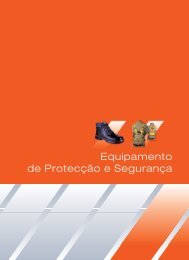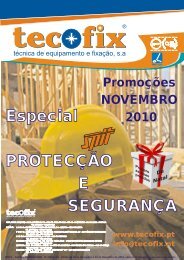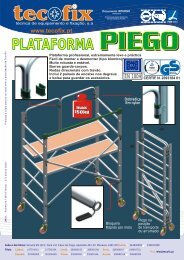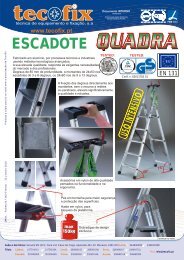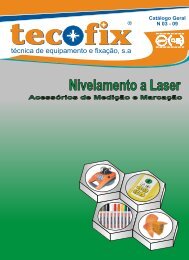Anclajes de fijación quÃmica - tecofix
Anclajes de fijación quÃmica - tecofix
Anclajes de fijación quÃmica - tecofix
Create successful ePaper yourself
Turn your PDF publications into a flip-book with our unique Google optimized e-Paper software.
Método <strong>de</strong> dimensionamiento CC<br />
PRINCIPIO<br />
En esta guía utilizamos el método <strong>de</strong> cálculo SPIT-CC (capacidad <strong>de</strong>l hormigón). Se trata <strong>de</strong> un método simplificado <strong>de</strong>rivado <strong>de</strong>l<br />
método A, <strong>de</strong>tallado en el Anexo C <strong>de</strong> la Guía ATE.<br />
¬ Resistencia a tracción<br />
¬ Resistencia a cizallamiento<br />
Rotura por extracción-<strong>de</strong>slizamiento Rotura <strong>de</strong>l cono <strong>de</strong> hormigón Rotura <strong>de</strong>l acero<br />
N = O<br />
Rd,p<br />
NRd, p. fb<br />
N = O<br />
Rd,c<br />
NRd c. f . ΨΨ .<br />
O<br />
N Rd , p<br />
.f b<br />
Resistencia en el estado<br />
límite último - rotura por<br />
extracción-<strong>de</strong>slizamiento<br />
Coeficiente que tiene en cuenta<br />
la resistencia <strong>de</strong>l hormigón<br />
O<br />
N Rd , c<br />
.f b<br />
.Ψ s<br />
.Ψ<br />
cN ,<br />
.f b<br />
.Ψ s<br />
.Ψ<br />
cN ,<br />
, b s c,<br />
N<br />
Resistencia en el estado<br />
límite último - rotura <strong>de</strong>l<br />
cono <strong>de</strong> hormigón <strong>de</strong> un<br />
anclaje en macizo<br />
Coeficiente que tiene en cuenta<br />
la resistencia <strong>de</strong>l hormigón<br />
Coeficiente que tiene en cuenta la<br />
influencia <strong>de</strong> la distancia entre ejes<br />
Coeficiente que tiene en<br />
cuenta la influencia <strong>de</strong> la<br />
distancia a los bor<strong>de</strong>s<br />
β V<br />
Ψ V<br />
C S V<br />
Rd,cp = O<br />
VRd cp ⋅ f ⋅ Ψ ⋅<br />
O<br />
V Rd,<br />
cp<br />
Resistencia en el estado<br />
límite último - rotura por<br />
efecto <strong>de</strong> palanca <strong>de</strong> un<br />
anclaje en macizo<br />
Coeficiente que tiene en cuenta<br />
la resistencia <strong>de</strong>l hormigón<br />
Coeficiente que tiene en cuenta la<br />
influencia <strong>de</strong> la distancia entre ejes<br />
Coeficiente que tiene en<br />
cuenta la influencia <strong>de</strong> la<br />
distancia a los bor<strong>de</strong>s<br />
N Rd,s<br />
N Rd,s<br />
N Rd = mín(N Rd,p ; N Rd,c ; N Rd,s )<br />
β N = N Sd / N Rd<br />
Rotura <strong>de</strong>l hormigón en el bor<strong>de</strong> <strong>de</strong> la losa Rotura por efecto <strong>de</strong> palanca Rotura <strong>de</strong>l acero<br />
O<br />
V V . f . f .<br />
Rd,c<br />
O<br />
V Rd , c<br />
.f b<br />
¬ Resistencia combinada<br />
(oblicua)<br />
f<br />
β , V<br />
Ψ<br />
CS , −V<br />
=<br />
Rd , c b , , −<br />
Resistencia <strong>de</strong> cálculo en el<br />
estado límite último <strong>de</strong> un<br />
anclaje situado a C min <strong>de</strong> los<br />
bor<strong>de</strong>s<br />
Coeficiente que tiene en cuenta<br />
la resistencia <strong>de</strong>l hormigón<br />
Coeficiente que tiene en<br />
cuenta la dirección <strong>de</strong> carga<br />
a cizallamiento<br />
Coeficiente que tiene en cuenta<br />
la influencia <strong>de</strong> la distancia entre<br />
el anclaje y un bor<strong>de</strong> libre<br />
, b S Ψc,<br />
N<br />
V Rd = min(V Rd,c ;V Rd,cp ; V Rd,s )<br />
β V = V Sd / V Rd<br />
β<br />
β<br />
β<br />
N<br />
V<br />
N<br />
N<br />
=<br />
sd<br />
NRd<br />
≤ 1<br />
V<br />
=<br />
sd<br />
VRd<br />
≤ 1<br />
+ β ≤ 12 ,<br />
V<br />
V Rd,s<br />
V Rd,s<br />
Resistencia <strong>de</strong> cálculo en el<br />
estado límite último - rotura<br />
<strong>de</strong>l acero<br />
Resistencia <strong>de</strong> cálculo en el<br />
estado límite último - rotura<br />
<strong>de</strong>l acero<br />
¬ Resistencia combinada ¬ Resistencia a cizallamiento ¬ Resistencia a tracción<br />
(oblicua)<br />
8<br />
El anclaje es a<strong>de</strong>cuado para su aplicación



